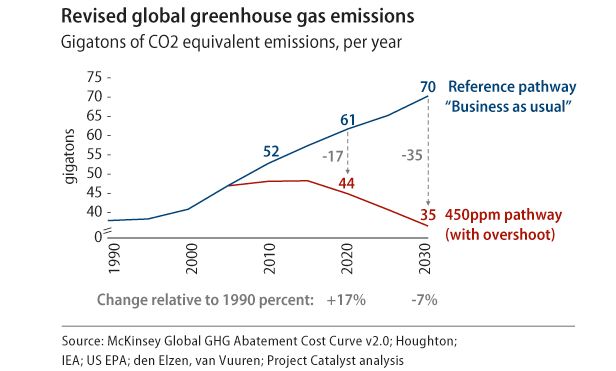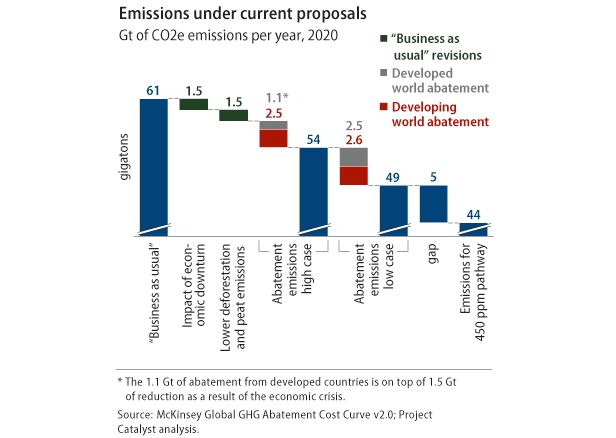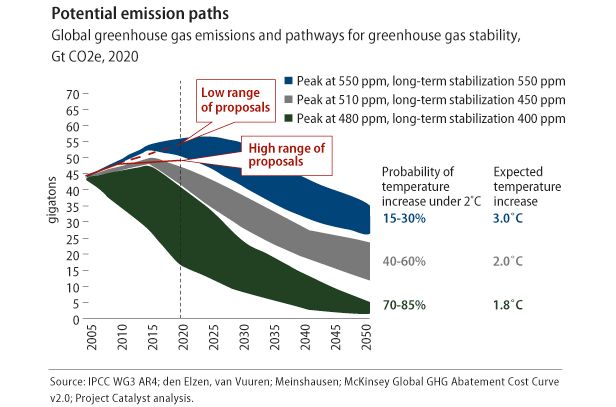
Delegates in Copenhagen are struggling through the difficult start of the second week of talks, with charges and counter-charges that one party or another is not doing their part to save the planet and the future of humanity thick on the ground. This is not atypical in the history of the U.N. climate meetings, but it has never been productive.
Where some see plenty of blame to go around, Center for American Progress (CAP) sees plenty of credit to go around. The current and pending policies among the world’s major carbon emitters are not yet sufficient to ensure that we will get to climate safety. Yet they are nonetheless a good start and could be built upon to achieve needed reductions to limit temperature increases to 2 degrees C over pre-industrial levels.
CAP has over the past year documented the numerous policies that both developed and developing countries have been pursing to create a low-carbon future. Our core message is that Americans should recognize that China, India, Brazil, Indonesia, and other major emitters in the developing world are doing much more to reduce their emissions than is commonly thought. But the same is true of the United States’ contribution to reducing emissions. Pending legislation from Congress would do much more to reduce emissions than is currently realized.
We believe that a common blindspot distorts recognition of the full reductions available from both developed and developing countries.
There appears to be a bias in global negotiations against counting what are called “complementary” or “sectoral measures” as seriously as we count economywide instruments. The result is an undercounting and under-appreciation of the range of reductions any party can bring to the table to contribute to the global reductions in carbon pollution. For that reason, we began promoting an approach last spring called “carbon cap equivalents.” The idea is to come up with a fair way of aggregating all emission reduction policies and represent them as one number rather than pointing to an array of different policies and talking about them separately — 5 percent here for one policy, 3 percent there for another, and 15 percent overall for an economywide measure such as a cap-and-trade program. Such a disaggregated view does not indicate the real depth of reductions possible by any party as much as it catalogues a range of policies as if they were seeking disparate goals.
It is common in the international negotiations to recognize that developing countries will need to seek different paths to achieving needed reductions due to national circumstances. We agree, and a cap equivalent approach allows us to add all of those different policies to represent each country’s full contribution to reductions in emissions. But we believe that we should measure carbon cap equivalents for every party — not just developing countries that do not have economywide measures at present in their proposals for emissions reductions — but developed countries as well who differ in their national political circumstances. Some developed countries, for example, will be able to join an international regime of emissions trading, and some will not because they are limited by the terms of their domestic political debates in the ambition of their economywide measures. We also embrace a treaty architecture that recognizes more limited programs for emissions reductions for all parties under one list, schedule, or registry.
Some of the alternative architecture for a successor agreement to the Kyoto Protocol proposed by Australia and South Korea would allow for counting carbon cap equivalents as a parties’ commitment to binding carbon reductions. Such an approach might be able to show, for example, that the United States will come closer to meeting other countries’ announced contributions to emissions reductions than is currently acknowledged, and that China is already taking serious steps to reduce its emissions.
For now though, such an approach could demonstrate to those gathered in Copenhagen that the world is heading in the right direction if all of the heaviest carbon polluters do what they say they are going to do to reduce their emissions. It would also shine a spotlight on why we need a strong international treaty right now — namely, to provide the right combination of incentives and compliance provisions to get all parties to do what they say they are going to do, and also produce a framework to encourage and insure greater ambitions to get us to some degree of climate safety.
CAP will release a full report on this project in the early months of 2010. Here are some early findings, aligned to some other recently released data that is similarly helpful.
Progress in the United States
The United States is the world’s largest per capita carbon emitter and the world’s largest historical emitter of carbon pollution. Yet the United States has not been at the table with the rest of the world as a constructive participant in either the Kyoto Protocol or a possible successor to it, and so we have essentially bankrolled almost a decade of cumulative frustration in the U.N. climate negotiations.
Many of our friends and allies are relieved that we now have an administration that is ready to seriously move forward on a global agreement to either compliment or replace the Kyoto protocol once its first commitment for mandatory reduction period expires in 2012. Nonetheless many of these same parties are frustrated with what we are bringing to the table.
Our midterm emissions targets are the primary frustration. The Intergovernmental Panel on Climate Change, or IPCC, argues that we can only meet the goal of limiting an increase in temperatures from climate change by 2 degrees C — which is most likely necessary to avoid the worst effects of climate change — if we cut global emissions by half by 2050. The IPCC recommends that developed countries cut emissions 80 percent below 1990 levels by 2050 to limit the increase in temperature to tolerable levels, something that the Obama administration has accepted as the right goal along with other developed countries. But the IPCC advises that developed countries reduce emissions 25 percent to 40 percent below 1990 levels at the 2020 midterm mark to put us on a pathway to safety.
President Obama is going to Copenhagen with a promise to agree to 2020 emissions cuts “in the range of” 17 percent below 2005 levels. This number is not coincidentally the same as the proposed 2020 target for an economywide reduction in the American Clean Energy and Security Act, or ACES, which passed our House of Representatives last summer, and lower than the 20 percent reduction proposed in the current Senate legislation sponsored by Senators Barbara Boxer (D-Calif.) and John Kerry (D-Mass.).
Many of our allies find Obama’s number disappointing against their promises to reduce emissions closer to the range recommended by the IPCC, if not exceeding it. It falls very far short of the European Union’s 2020 commitment to reduce emissions by 20 percent below 1990 levels. When we convert the United States’ 2020 ambition to a 1990 baseline it only amounts to either returning to 1990 levels or a relatively slight reduction. The E.U. has pledged that it will trigger an increase in their emissions reductions from 20 to 30 percent below 1990 levels if other developed countries make a comparable effort to their 2020 reductions, which would hit much closer to the mark of the IPCC’s recommendations. At this point, the range of reductions being put on the table by President Obama cannot hope to start this ramp up of ambition in the European Union, and so those needed tons of emissions will not be subtracted from the global tally.
Yet several organizations have looked at the numbers in the pending U.S. legislation and concluded that even greater emissions reductions are possible than those represented in the economywide caps. A recent study by the World Resources Institute calculates that ACES could achieve emissions reductions of 23 percent below 1990 levels if all complementary measures are taken into account, such as the set-aside in the legislation for direct assistance to avoided deforestation initiatives in developing countries and the more restricted energy efficiency goals for limited sectors of the economy.
The Center for American Progress has worked with Project Catalyst to verify some of this analysis. CAP is pleased today to report that our estimate of the total emissions reductions from existing and pending U.S. policies could achieve reductions of 12 percent below 1990 levels by 2020 rather than only returning to 1990 levels. These additional reductions would come from the proposed international forestry conservation “set-aside” in ACES — separate from the allocation for forestry offsets — and the abatement measures in the American Recovery and Reinvestment Act, as well as other smaller complementary policies such as new appliance standards and tighter restrictions on auto emissions. A recognition of this potential reduction might very well help the world see the United States’ commitment to reductions in a new light and could provide support, for example, to Prime Minister Gordon Brown’s recent argument that the E.U. move forward with its 30 percent midterm commitment even if not every party recognizes the approaching parity of the U.S. midterm contribution to the E.U. on this analysis.
Excluding the forestry set-aside from this analysis, however, would mean that the United States would return to 1990 levels by 2020 according to previous data released by Project Catalyst. This is all the more reason for recognizing the urgency of retaining provisions such as the forestry set aside in the companion bill working its way through the Senate. And it shows how important it is to take a cap equivalent approach to counting all the numbers that various parties are putting on the table.
Progress around the world
The general philosophy of counting everything, without double counting anything, ought to govern how we view the contributions of other countries, as well. Most critics of domestic climate legislation in the United States use the argument that we shouldn’t do anything because (a) U.S. contributions to reducing emissions alone will not do much to reduce global emissions and (b) China, India, and the other major carbon polluters in the world will never follow us and we will put ourselves at a competitive disadvantage by curbing our own emissions.
Yet, as expected, shortly after President Obama put a concrete target on the table for Copenhagen, China, and India followed suit. China announced on Thanksgiving Day a target of reducing carbon emissions per unit of GDP by 40 to 45 percent from 2005 levels by 2020. India went next with a carbon intensity reduction target of 20 to 25 percent below 2005 levels by 2020.
Modeling by Project Catalyst and the Center for American Progress estimates that China and India’s carbon intensity targets are less ambitious than previously announced policies. Yet analyses of other complementary policies — including China’s energy intensity target in the 11th five-year plan and India’s National Action Plan on Climate Change — reveal a carbon cap equivalent figure that demonstrates that China and India could still reduce their emissions 13 percent and 19 percent respectively below business as usual by 2020. At least in the case of India, these policies are proposed and not yet enacted, as is true in the Untied States.
These carbon cap equivalent estimates include China’s commitments to generate 10 percent of their electricity from renewable energy sources by 2010 and 15 percent by 2020, as well as their plan to strengthen fuel efficiency standards. It includes India’s previously announced solar energy goal, the most ambitious in the world, and their movement toward a plan to radically improve home appliance efficiency. CAP’s report next year with Project Catalyst will update the emissions reductions possible from current and pending policies among the 17 largest emitters, developed and developing, responsible for 85 percent of the global carbon pollution. We believe, along with many others, that an agreement to curb emissions among this smaller group of nations would be sufficient to achieve the reductions needed to protect the welfare of future generations.
Our carbon cap equivalent work has focused on various parties’ reductions below a benchmark — 1990 carbon emissions, 2005 emissions, or what they would have emitted without abatement. But it helps to see the true power of counting everything to assess our global progress on this problem by looking at the tons of carbon that can be potentially taken out of the system by each country. Here we see not only where the world could be heading if various parties fulfill their national commitments, but the comparative contributions of developed and developing countries.
A recently released study by Project Catalyst, “Taking Stock,” finds that climate change pollution will rise to 58 gigatons, or Gt, per year by 2020 if we continue on a business as usual pathway. This same organization had previously estimated that emissions would rise to 61 Gt in the same period but the global recession and revised estimates from deforestation and peat emissions reduced the number. They conclude that the reductions in absolute tons of carbon pollution needed by 2020 to get on a pathway to stabilize atmospheric concentrations at 450 parts per million — which has been argued to be the concentration necessary to hold temperature rise to 2 degrees C — is 14 Gt of reductions below business as usual requiring yearly cuts starting in 2010.
Project Catalyst went on to evaluate current country proposals for the 17 largest emitters, both those in place and those on the table, such as signing a bill into law in the United States such as ACES, or the E.U. increasing its 2020 commitment by 10 percent. The analysis of each country’s proposals amounts to a carbon cap equivalent figure for each country. The results are encouraging.

Current and pending equivalent proposals would reduce emissions 49 to 54 Gt per year in 2020. Of course, the extent to which this range is realized is dependent on whether all parties who have a national proposal on the table for emissions reductions do what they claim they will do. Brazil can reduce its emissions 39 percent below business as usual if developed countries encourage its commitment to reduce deforestation in the Amazon and other areas with financial assistance; if not, it will only reduce its emissions 5 percent. And while much of the discussion in Copenhagen will focus on assistance from developed to developing countries, which is absolutely critical to resolve to get a global deal, we are encouraged that there are now proposals on the table to get us 65 percent of the way toward a viable path of climate stabilization, or, only 5 gigatons away from the abatement required to hold atmospheric concentrations of carbon pollution at 450ppm.
Moreover, and possibly more important in some respects, this analysis reveals that the bulk of the emissions reductions in both the low case and high case scenarios are coming from developing countries. This may not be true in terms of the percentage of their current emissions, but it is true in terms of the absolute tons of CO2 and CO2 equivalent that they will at present and can in the future take out of the system. The developed world will achieve 1.1 Gt of abatement in the low case and 3.6 Gt in the high case. The developing world will achieve 2.5 Gt in the low case and 5.1 Gt in the high case. If everyone does everything promised today, developing countries will be the source of 1.5 Gt more greenhouse gas emissions out of the system. Not all of those reductions will be financed directly from these host countries, but much of it will, and those sources of reductions need to be respected as we move forward to safety into a regime of equitable reductions in emissions from all major economies.

Finally, locking in these proposed emissions reductions is critical, and that is where it is necessary for an international agreement to bind parties to their commitments and provide appropriate and equitable incentives, where necessary, for achieving these reductions. Even with the encouraging news from this report, we are still left with the necessity of finding an additional 5 gigatons of emissions to remove from the system in order to get on the 2020 stabilization pathway. An international treaty that raises ambition for all parties to shoot for better national goals is necessary to find those additional reductions.
We will turn to these challenges in our full report on the carbon cap equivalent approach in the new year when, hopefully, we will have a better view of what is possible for a new international climate agreement and final domestic energy and climate legislation.
Spread the news on what the føck is going on in Copenhagen with friends via email, Facebook, Twitter, or smoke signals.




